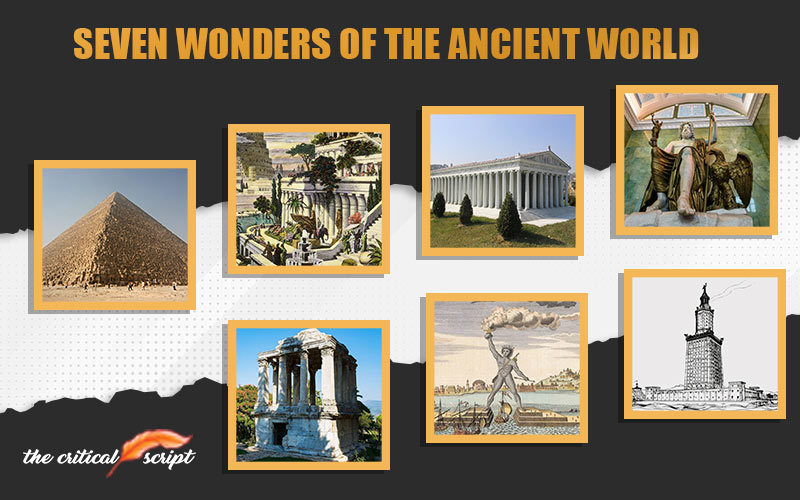
Seven Wonders of the Ancient World
The 7 ancient wonders of the World are a collection of remarkable structures built by various civilizations of the ancient world.
These include-
1. The Great Pyramid of Giza
2. The Hanging Gardens of Babylon
3. The Temple of Artemis at Ephesus
4. The Statue of Zeus at Olympia
5. The Mausoleum at Halicarnassus
6. The Colossus of Rhodes
and 7. the Lighthouse of Alexandria.
The Great Pyramid of Giza: The Great Pyramid of Giza is the largest Egyptian pyramid and served as the tomb of pharaoh Khufu, who ruled under the Fourth Dynasty of the Old Kingdom. Built-in the early 26th century BC, over a period of about 27 years, the pyramid is the oldest of the Seven Wonders of the Ancient World, and the only wonder that has remained largely intact and it stands at a height of 480 feet. It is the most famous monument of the Giza pyramid complex, part of the UNESCO World Heritage Site "Memphis and its Necropolis". It is situated at the northern end of the line of the three pyramids at Giza.
The Hanging Gardens of Babylon: The Hanging Gardens of Babylon were one of the Seven Wonders of the Ancient World listed by Hellenic culture. It stood as a testament to the extraordinary engineering abilities of the ancient Babylonians. It was said to be a remarkable feat of engineering with an ascending series of tiered gardens containing a wide variety of trees, shrubs, and vines, resembling a large green mountain constructed of mud bricks. It was said to have been built in the ancient city of Babylon, near present-day Hillah, Babil province, in Iraq. Although the Hanging Gardens no longer exist, it is believed that they were built during the reign of King Nebuchadnezzar II.
The Temple of Artemis: The Temple of Artemis or Artemision, also known as the Temple of Diana was a Greek temple dedicated to an ancient, local form of the goddess Artemis – one of the most revered goddesses of the ancient world. It was built around 550 BCE and stood at a height of 60 feet. It was located in Ephesus (near the modern town of Selçuk in present-day Turkey). By 401 AD it had been ruined or destroyed. Only foundations and fragments of the last temple remain at the site.
The Statue of Zeus: The Statue of Zeus at Olympia was a giant seated figure, about 12.4 m (41 ft) tall, made by the Greek sculptor Phidias around 435 BC at the sanctuary of Olympia, Greece, and erected in the Temple of Zeus there. Zeus is the sky and thunder god in ancient Greek religion, who rules as king of the gods of Mount Olympus. The statue was a chryselephantine sculpture of ivory plates and gold panels on a wooden framework. Zeus sat on a painted cedarwood throne ornamented with ebony, ivory, gold, and precious stones. It was also one of the Seven Wonders of the Ancient World.
The Mausoleum: The Mausoleum at Halicarnassus was another impressive structure built by the ancient Greeks. Built-in around 350 BCE by Queen Artemisia II of Caria in honor of her husband, it stood at a height of around 140 feet. Unfortunately, the mausoleum no longer exists as it was destroyed by earthquakes in the 12th and 15th centuries. It contained a total of 400 freestanding sculptures. The mausoleum was considered to be such an aesthetic triumph that Antipater of Sidon identified it as one of his Seven Wonders of the Ancient World.
The Colossus of Rhodes: The Colossus of Rhodes was a bronze statue of the Greek god Helios, erected around 280 BCE on the Greek island of Rhodes. It stood at a height of around 100 feet and was considered one of the tallest statues of the ancient world. It was constructed to celebrate the successful defense of Rhodes City against an attack by Demetrius Poliorcetes, who had besieged it for a year with a large army and navy.
The Lighthouse of Alexandria: The Lighthouse of Alexandria, sometimes called the Pharos of Alexandria, was another impressive structure built by the Ptolemaic Kingdom of Ancient Egypt, during the reign of Ptolemy II Philadelphus. It was around 400 feet tall and was built in around 300 BCE. The lighthouse was considered an engineering marvel and was a landmark for sailors navigating the Mediterranean Sea for many centuries. The lighthouse was severely damaged by three earthquakes between 956 and 1323 AD and became an abandoned ruin. It was the third-longest surviving ancient wonder, after the Mausoleum at Halicarnassus and the extant Great Pyramid of Giza, staying in part until 1480 when the last of its remnant stones were used to build the Citadel of Qaitbay on the site.
The 7 ancient wonders of the world are a testament to the ancient civilizations' incredible ingenuity and engineering skills. These structures continue to fascinate us with their size, complexity, and beauty and have stood the test of time as a testament to human accomplishment.
Disclaimer: The opinions expressed in this article are those of the author's. They do not purport to reflect the opinions or views of The Critical Script or its editor.

Newsletter!!!
Subscribe to our weekly Newsletter and stay tuned.

















Related Comments